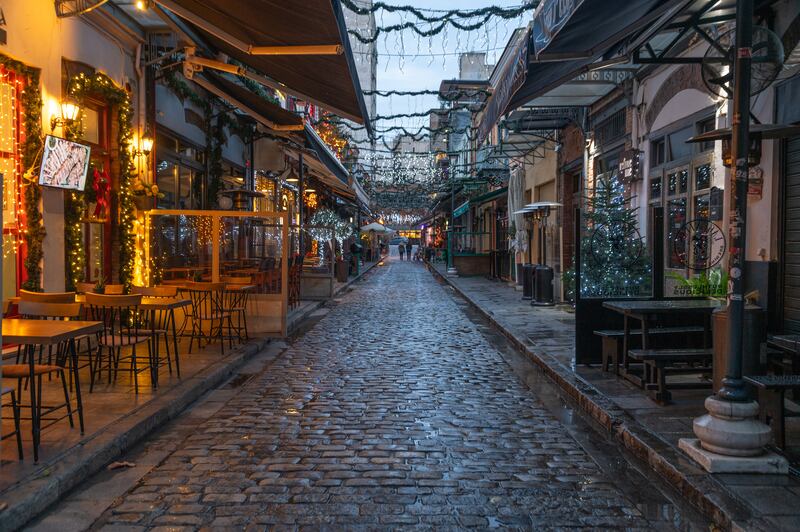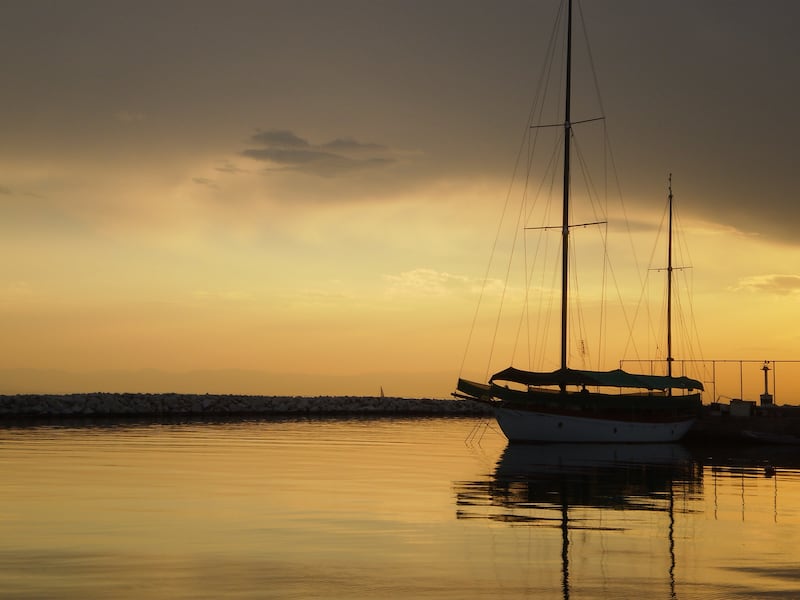Travel
Travels through time in Thessaloniki: I stood beside my grandfather’s headstone and remembered the younger me

It was by accident rather than design, in the summer of 1968, that I found myself for the first time in Thessaloniki, in the northern Greek province of Macedonia. My plan had been to head for the hippy colony in the Caves of Matala on the south coast of Crete. However, a teacher in Athens had told me that the military government was taking a dim view of the surge in the number of hippies, draft dodgers, “flower children” and other foreigners appearing on the Greek Islands.
I decided to hitch north instead. As I generally did on my long hitchhiking journey from Ireland, I advertised to passing vehicles in big letters on a piece of cardboard my next destination of Thessaloniki. The name resonated with me because it was part of my own history: it was the place where my grandfather, a soldier who went off to war in 1914, had found his final resting place.
Fast forward to a sunny Thursday morning in October 2024. I was back in Thessaloniki, just outside my accommodation, a little boutique hostel called The Crossroads, perched in the high northern suburb of Agios Pavlos. It was the morning after my Ryanair flight and, with those “first morning” eyes, I contemplated the vista before me.
Across the vast white city below, mythical Mount Olympus stood proud along a line of deep blue mountains on the southwestern horizon. Off to the southeast, in lingering morning haze, Mount Athos seemed to claim its own theological space among the high wooded hills of the beautiful Khalkidhiki Peninsula. I hoped to visit both mountains.
But first there was Thessaloniki. This city, unlike Athens, Barcelona or Rome, is not to Irish visitors a typical tourist destination. It is, however, a teeming, authentic Greek city of chatter, coffee shops, patisseries, street eating and strolling. All over the city, in gaps between rows of tall buildings, brown weathered ruins poke up like old, uncovered bones, some with helpful information panels, others enigmatically silent, their stories untold. Some are the remnants of Thessaloniki’s Romano-Greek golden age, that of the Emperor Galerius (r. 305-311), as they are at the city’s focal and meeting point, the Triumphal Arch of Galerius, and his largely intact Mausoleum and less well preserved Palace.
As a solo traveller with no one to please but myself, I spent hours at the Archaeological Museum of Macedonia, delving into the timeline of archaic Greek, the flowering of the Macedonian kingdoms of Philip and Alexander the Great, and on through the violent coming together of Roman and Greek culture.
The city’s history is one of splendour and enrichment as the second city to Constantinople during the later Roman (or “Byzantine”) period, even as Rome itself and the western empire disintegrated. Ultimately, it too was to fall in the early 1400s, and from then to the early 1900s there followed lengthy periods of relative calm under the Ottomans, punctuated by periods of violence and suppression.
From history to practicalities: my second day involved an early start. The bus to Ouranoupoli, the gateway to the Mount Athos restricted Monastic area, left at 6am. Fortunately, the three-hour morning journey was lovely, driving through still-sleeping villages and over wooded hillsides of early morning grey.
Passengers were virtually all dark-clothed, heavy-set and dour-looking men, some Russian, and one snoring mightily as we went. Much later, I watched them emerge from the Holy Executive of the Holy Mount Athos – Pilgrims’ Bureau in Ouranoupoli, clutching their entry permit for Mount Athos. They were on their way to the nearby ferry, on their Orthodox Christian pilgrimage to one of the many male-only monasteries of the Holy Mountain.
My tour was a slow, three-hour cruise along the west shore of the easternmost point of the Khalkidhiki Peninsulas. Being a cruise of men and women passengers, we were required to stay 500m offshore from Holy Mount Athos.
As we travelled we were informed that in the early Christian period, hermits established themselves through the wooded and then uninhabited hills of that beautiful peninsula, motivated by the same need for spiritual isolation as our own monks on Sceilg Mhichíl. Later, in the 900s, more organised monasticism was established, and a great number of monasteries were built on the shores and in the wooded hills. In later years, the settlements became prey to pirates, the notorious Catalan Company of mercenaries, and, after 1430 or so, ruinous taxation by the occupying Ottoman authorities.
We listened to all these stories, as we glided by monastery after monastery, many of them semi-deserted. The slow swell, the silence of the hills and shores, made it feel as though we were travelling back in time, to gain a glimpse of another world.
The next day offered an intensely personal experience. I walked about 12km right across the city to Mikra, in the suburb of Kalamaria, where my grandfather was interred, feeling the emotion in me build as I got closer and closer.
I walked slowly along each neat row of nearly 2,000 headstones in the beautifully maintained Mikra Cemetery. The names and cold white headstones spoke to me of pain and loss and death in strange places away from loved ones. All this suffering was at odds with the dignity, peace, calm and tranquillity of the place where each person, mostly young and many Irish, now occupied their little piece of Greek ground.
I stood beside my grandfather’s headstone and remembered the young version of me standing there in 1968. I also remembered the cool late autumn day of 1982, when I stood there with my own father. Later, over a meal and beers downtown in Thessaloniki, my father told me again of his sadness as a seven-year-old boy, watching his father go out the door and disappear forever from his life – but not before he paused and walked back to give one last hug to the little boy that was my father. It was as if he glimpsed perhaps what might lie ahead for himself and for his son.
The whole Guilfoyle family came there in 2000, and I visited on a long cycle from Beziers in France to Istanbul in 2012, on much of the same way as on my hitchhiking route of 44 years before. But these are other stories, for another time.

The next two days were upbeat and mostly relaxed, days of woodland and mountain hiking, and exploring the lovely gateway to the Mount Olympus National Park in the picturesque town of Litochoro.
I swapped the noise and vibrancy of the big city for quiet birdsong, mountain air and paths of autumn leaves and slanting sunshine. And I swapped the emotion of Mikra Cemetery for the lightness, and even fun, of walking my legs and imagination into the world and stories of the Old Gods, and of the myriads of nymphs, dryads and satyrs whose antics in these woods, and elsewhere in this fabled land, have enthralled and enriched the imaginations of generations.
My hikes over those days were on the E4 long distance European trail that runs from Greece to Spain, a path that conveniently passes through Litochoro and ventures high over the shoulder of Mount Olympus, my favourite of my two Holy Mountains. Though I had more ambitious plans, I wisely and happily contented myself to walk and wander the Epineas Gorge between Litochoro and Prionia.
Along the way, on my second hiking day, I lit a candle to the new Gods in the little trailside hermitage tucked into the Cave of Agios Dionisius. I needed their help on an upcoming tricky descent of 12km, where I’d been warned that the wooden footbridges over the Epineas river had been destroyed.
My last day, before my late-night Ryanair flight home, I spent mostly hanging out on the wonderfully sunny 12km-long promenade of Thessaloniki. In the morning, I joined a walking tour of the city. And, in the late afternoon because I could, I took a 30-minute cocktail cruise of the bay.

As evening closed in, I hauled myself up the 25-minute 200mt climb to the Crossroads Hostel. I bade farewell to the friendly young hostel staff and had my last meal of prawns and linguine and semi-sweet Greek wine in nearby Krionidis’ Balcony restaurant. And with that great compensation of the solo traveller, I mindfully took in a slow Macedonian sunset over the hills of distant Mount Olympus, and noted the old Roman walls becoming warmly floodlit against a darkening sky.









